|
|
Cicada Biology - Family Cicadidae
This page contains pictures and information about Cicada Biology in general.
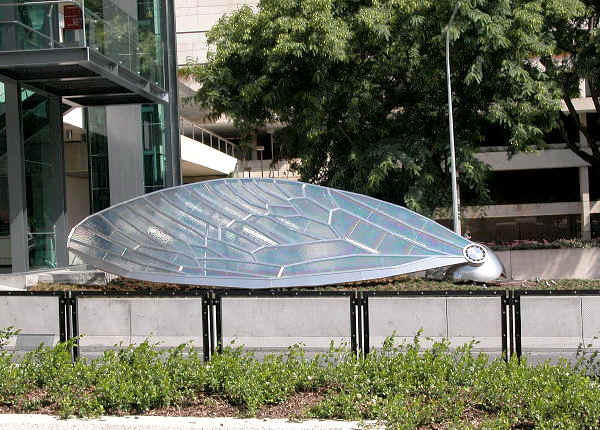
- Largest Cicada we found in Brisbane, body length over 10 meters, outside Culture Center
- Cicadas are well known because their 'song' is the back ground noise here in summer. Their empty shells often seen on tree trunks and fences. The young nymphs live underground suck the roots of trees. They may live underground for many years, come up from soil in summer, have the final moulting and leave those empty shells. This is the male who sing the song to attract female. Each species have different 'songs'.
- Most of them are active during the day, a few species active only at night.
Female lays eggs on stem.
-



- Females cut slits in branches by ovipositor and lay eggs inside in group. Nymphs hatch and drop to ground and burrow into soil. They have strong fore legs to move in the soil. The young nymphs live underground suck the roots of trees. Some species have the annual life-cycle and some may live underground for years. There are usually five instars stages.
Empty shells on tree trunk
- Before becoming adults, they come up from soil, have the final moulting and leave those empty shells. This usually happen after dusk in summer night. After coming out for soil, they will find any near-by vertical items, usually tree trunks or grass stems, climb up for the moulting.
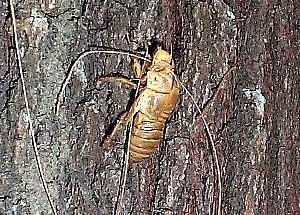
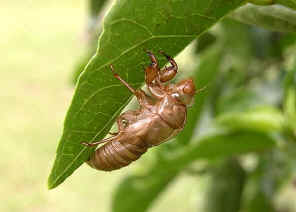

- Their empty shells are often seen on tree trunks and fences.
-



- On end Dec 2007 in Karawatha forest (we believe it would be the same for most other area in Brisbane), many adults emerge together and clusters of empty nymph skins (called exuviae) were seen around the bases of tree trunks. We had been visited the forest every week for the last few months and did not remember seeing so many exuviae, although we noticed those Double Drum Cicadas had started singing few weeks ago.
- Every medium to large size tree trunks, at least two or three exuviaes were found. Some large tree trunks had more than 20. Some exuviaes were even seen on tall grasses and vertical rock surfaces.



- We also saw many new holes of diameter 25mm on footpaths in the forest. Of course there were many similar holes on the forest ground, but not seen because covered by fallen plants materials.
- In that day, we also saw some of those cicadas flying between gum tree tops. Some area in the forest, the songs were so loud that we could not hear each other when we were talking face to face.
- In general, just before emerging, those matured nymphs will dig their way from the root underground where they live and move to just below the soil surface. They may be waiting for some environment signals or conditions to emerge. Then suddenly all of them are synchronized together and come out from the ground. They find the closest vertical surface, such as a large tree trunk, climb up about half a meter then start to emerge to become adults.
- Most cicada species, including this Double Drummer, emerge at night. The cicada in the following pictures could emerge a bit later than normal. It had already emerged outside the exuviae when we first saw it.

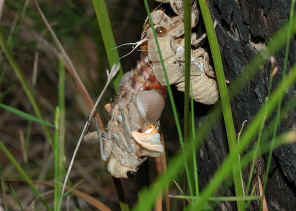

- 11:00am already emerged outside exuviae, head downwards



- 11:10am wings started expanding, head moving upwards



- 11:15am wings fully opened



- 11:30am wings folded into tent shape position.
- Then the cicada would keep in this position until both its wings and skin were harden. Its pale body colour would become darken as well.
Adult Emerging
Cicada Song
- Cicadas are familiar in Brisbane because their 'songs' are the back ground noise here in summer.
 Sound
of Floury Baker Cicada.
Sound
of Floury Baker Cicada. - This is the male who sing the song to attract female. Only the males have the sound producing organ but both male and female have the hearing organ. Each species have different 'songs' which are produced by two organs called timbals on each side of their abdomen. The sound is produced by tymbals, an organ with mechanism working like the children's tin clicker toys. The male cicadas vibrate the membranes by internal muscle and the sound is resonate with the drum-like cavity in the abdomen and this amplify the sound. The songs are primarily for finding mate, but may also for aggregation of males and repel predators.
 Watch
the Floury Baker Cicada singing.
Watch
the Floury Baker Cicada singing.
8.0 seconds of sound waveform and spectrum.
Cicada's Natural Enemy
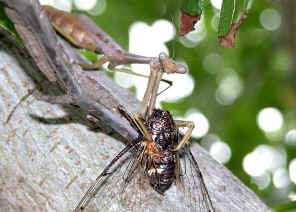


- One hot summer weekend when I was working in front of my computer on this Brisbane Insects and Spiders web site, as usual I heard many of this Floury Baker Cicadas singing outside in our backyard on the Maple tree. Suddenly I heard a new cicada song. The song had quite different pattern which I had never heard before. I thought there must be a new species of cicadas came to visit us. I immediately took my camera outside and look for it. What I found was not a new cicada species. Instead it was a Floury Baker Cicada attacked by a Praying Mantid. The cicada might try to deter the mantid but with no luck.

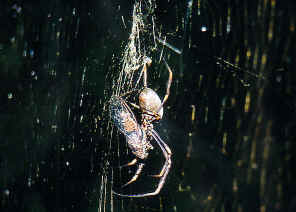

- Beside mantids, spiders are also cicada's major natural enemy. The first picture above shows the Red Back Spider having a large meal, a Brown Bunyip Cicada. The second picture shows a Golden Orb Spider captured another cicada. Third picture shows a bad luck Clanger on spider web.
- Reference and links:
- 1. Insects of Australia, CSIRO, Division of Entomology, Melbourne University Press, 2nd Edition 1991, pp 464.
- 2. Family CICADIDAE - Australian Biological Resources Study, Department of the Environment and Heritage.
- 3. Cicadas – our Summer Singers - Geoff Monteith, Queensland Museum, September 2000.


